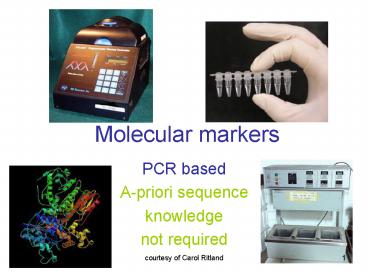Molecular markers - PowerPoint PPT Presentation
1 / 30
Title:
Molecular markers
Description:
Molecular markers PCR based A-priori sequence knowledge not required * courtesy of Carol Ritland * PCR markers a prior sequence knowledge RAPD AFLP SCARS CAPS AP-PCR ... – PowerPoint PPT presentation
Number of Views:217
Avg rating:3.0/5.0
Title: Molecular markers
1
Molecular markers
- PCR based
- A-priori sequence
- knowledge
- not required
2
PCR markers a prior sequence knowledge
- RAPD
- AFLP
- SCARS
- CAPS
- AP-PCR
- RAMPO
3
RAPD
- Randomly Amplified Polymorphic DNA
- Using a short primer (8-12 nucleotides)
- No prior sequence knowledge is required
- Require intact genome
- Dominant marker
- A major short fall Lack of reproducibility
- Welsh, J. and McCelland M. Nucleic Acid Res 1990
187213-7218 - Williams et al. Nucleic Acid Res. 1990
186531-6535
4
3 individuals
Oligos (8 to 12 nucleotides)
Will produce products when primers are close
together to produce fragment sizes that can be
visualized
Oligos will anneal on both strands search for
palidome sequences on both strands
5
PCR products formed for all individuals
6
PCR products for only two individuals
7
(No Transcript)
8
(No Transcript)
9
- RAPD marker has a major problem with dominance
- Previous example of individuals are shown as 2N
- In the next slide we will use chromatids (4 per
individual) to demonstrate dominance
10
(No Transcript)
11
RAPD Gels
size ladder
12
Example of RAPD gel
13
Scoring RAPD gel
Sample name (120bp) (130bp) (180bp) (220bp)
1101 1 1 0 1
1102 1 0 0 0
1103 0 1 1 1
1104 0 0 0 1
Sample name Locus A (Allele type) Locus B Locus C Locus D
1 2 2 1 2
2 1 2 1 2
3 2 1 2 1
4 1 2 1 1
14
A B C D E F G H I J
2000bp 800bp 600bp 300bp 100 bp
Score the following RAPD gel for these 10 samples
(A-J). Indicate the loci you are scoring with an
arrow on the right side of the image
Ladder (bp) A B C D E F G H I J
1
2
3
4
5
6
7
8
9
10
15
Issues to consider
- Some reproducibility problems, needs to use same
lot for all chemicals eg. buffer, Taq, dNTP etc. - Same band on gel same DNA fragment?
- One band on gel one DNA fragment?
- (Allele homoplasy)
- Selecting the band or lack of them to score
16
More issues.
- Anonymous markers - but can be converted to SCARs
or CAPs - Dominant markers - homozygotes cannot be
distinguished from heterozygotes - Fast, easy and cheap - commercial primer sets
available - Scoring is subjective and individual dependent
17
Applications
- Genetic Maps
- Fingerprinting isolates and cultivars
- Limited use today
18
AFLP
- Amplified Fragment Length Polymorphism
- Very sensitive
- Good reproducibility but can be technically
demanding - Combining RFLP and RAPD technique
- Dominant marker
- Generate fingerprint
- Can use DNA and cDNA
- Vos et al. Theor. Appl. Genet. 1995 234407-4414
19
AFLP flowchart
Courtesy of Ritland and Ritland
20
AFLP flowchart
Courtesy of Ritland and Ritland
21
AFLP flowchart
Courtesy of Ritland and Ritland 2000 Molecular
Methods in Ecology
22
Simple
Complex
23
A
B
C
D
E
Samples 1 2 3 4 5 27 28
Linanthus Courtesy of Carol Goodwille
24
Sample Locus A (bp) Locus B Locus C Locus D Locus E
1 1 1 0 1 0
2 0 1 0 1 1
3 1 0 1 1 1
4 1 0 1? 1 1
5 1 1 0 1 0
Example of sampling from Linanthus data (see
previous slide for image)
25
Scoring AFLP exercise
Samples 16 (A-P)
Indicate the loci you are scoring with an arrow
on the right side of the image
2550bp 2300bp 2004bp 2000bp 1750 bp
Size (bp) A B C D E F G H I J K L M N O P
1
2
3
4
5
6
26
Issues to consider
- Discriminating homozygotes from heterozygotes
- requires band quantification (possible gel
scanner) - Bands are anonymous - interpretation of patterns
- can be challenging
- Same position equal only one band?
- Dominant marker (difficult to test
Hardy-Weinberg) - Can try to look for co-dominant bands
- More expensive than RAPD markers
- Much more repeatable than RAPD markers
- Need to be technically consistent
- Need clean intact genomes and min. amount (500ng)
- May not be useful for population assignment
pending on population structure - Subjective scoring problem much like RAPD markers
- Non independence bands are difficult to detect,
problem for phylogeny construction
27
Applications for AFLP
- Physical mapping
- Genome mapping
- Population structure (clone detection)
- Genetic diversity
- DNA fingerprinting isolates or cultivars
- Detection of somatic clone contaminations
- Can convert segregating bands to co-dominant
markers - Forensic sciences
- QTL analysis
- Locating possible genes related to complex traits
(cDNA template)
28
Clonality study
- Wilson A.S.G., van der Kamp, B.J. and Ritland C.
(2005) Can J. Bot 831126-1132
- Clone identification
- Clone diversity
- Spatial structure
Maianthemum dilatatum
29
Comparing RAPD to AFLP
- Kjolner, S., Sastad, S.M.,Taberlet, P. and
Brochmann, C. (2004) Molecular Ecology 1381-86 - 4 populations (13-15 individuals per population)
Saxifraga cernua
30
Comparing AFLP and RAPD
- Both markers produced similar results in
estimating clone identity, clone relationships,
gene diversity, linkage disequilibrium - AFLP is superior in terms of efficiency but RAPD
may still be used as a cheaper method - Major caution with repeatability































